
Titan was a family of United States expendable rockets used between 1959 and 2005. The Titan I and Titan II were part of the US Air Force's intercontinental ballistic missile (ICBM) fleet until 1987. The space launch vehicle versions contributed the majority of the 368 Titan launches, including all the Project Gemini crewed flights of the mid-1960s. Titan vehicles were also used to lift US military payloads as well as civilian agency reconnaissance satellites and to send interplanetary scientific probes throughout the Solar System.
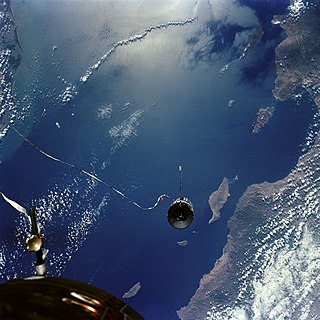
Gemini 11 was the ninth crewed spaceflight mission of NASA's Project Gemini, which flew from September 12 to 15, 1966. It was the 17th crewed American flight and the 25th spaceflight to that time. Astronauts Charles "Pete" Conrad Jr. and Richard F. Gordon Jr. performed the first direct-ascent rendezvous with an Agena Target Vehicle, docking with it 1 hour 34 minutes after launch; used the Agena rocket engine to achieve a record high-apogee Earth orbit; and created a small amount of artificial gravity by spinning the two spacecraft connected by a tether. Gordon also performed two extra-vehicular activities for a total of 2 hours 41 minutes.

SSL, formerly Space Systems/Loral, LLC (SS/L), of Palo Alto, California, is a wholly owned manufacturing subsidiary of Maxar Technologies.

The Titan IIIC was an expendable launch system used by the United States Air Force from 1965 until 1982. It was the first Titan booster to feature large solid rocket motors and was planned to be used as a launcher for the Dyna-Soar, though the spaceplane was cancelled before it could fly. The majority of the launcher's payloads were DoD satellites, for military communications and early warning, though one flight (ATS-6) was performed by NASA. The Titan IIIC was launched exclusively from Cape Canaveral while its sibling, the Titan IIID, was launched only from Vandenberg AFB.
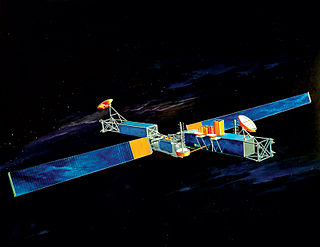
Milstar is a constellation of military communications satellites in geosynchronous orbit, which are operated by the United States Space Force, and provide secure and jam-resistant worldwide communications to meet the requirements of the Armed Forces of the United States. Six spacecraft were launched between 1994 and 2003, of which five are currently operational; the third launch failed, both damaging the satellite and leaving it in an unusable orbit.

The Defense Satellite Communications System (DSCS) is a United States Space Force satellite constellation that provides the United States with military communications to support globally distributed military users. Beginning in 2007, DSCS is being replaced by the Wideband Global SATCOM system. A total of 14 DSCS-III satellites were launched between the early 1980s and 2003. Two satellites were launched aboard the Space Shuttle Atlantis in 1985 during the STS-51-J flight. As of 14 September 2021, six DSCS-III satellites were still operational. DSCS operations are currently run by the 4th Space Operations Squadron out of Schriever Space Force Base.

Space Systems Command (SSC) is the United States Space Force's space development, acquisition, launch, and logistics field command. It is headquartered at Los Angeles Air Force Base, California and manages the United States' space launch ranges.

The Wideband Global SATCOM system (WGS) is a high capacity United States Space Force satellite communications system planned for use in partnership by the United States Department of Defense (DoD), Canadian Department of National Defence (DND) and the Australian Department of Defence. The system is composed of the Space Segment satellites, the Terminal Segment users and the Control Segment operators.
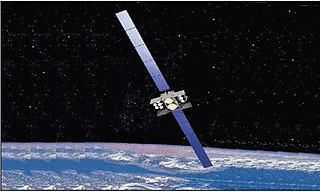
USA-195, or Wideband Global SATCOM 1 (WGS-1) is a United States military communications satellite operated by the United States Air Force as part of the Wideband Global SATCOM programme. Launched in 2007, it was the first WGS satellite to reach orbit. It is stationed at a longitude of 174.8° East.
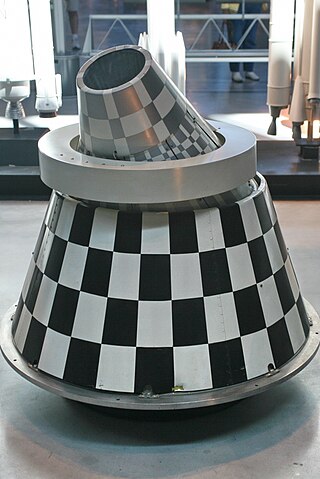
The Missile Defense Alarm System, or MIDAS, was a United States Air Force Air Defense Command system of 12 early-warning satellites that provided limited notice of Soviet intercontinental ballistic missile launches between 1960 and 1966. Originally intended to serve as a complete early-warning system working in conjunction with the Ballistic Missile Early Warning System, cost and reliability concerns limited the project to a research and development role. Three of the system's 12 launches ended in failure, and the remaining nine satellites provided crude infrared early-warning coverage of the Soviet Union until the project was replaced by the Defense Support Program. MiDAS represented one element of the United States's first generation of reconnaissance satellites that also included the Corona and SAMOS series. Though MIDAS failed in its primary role as a system of infrared early-warning satellites, it pioneered the technologies needed in successor systems.

Transtage, given the United States Air Force designation SSB-10A, was an American upper stage used on Titan III rockets, developed by Martin Marietta and Aerojet.

The 6555th Aerospace Test Group is an inactive United States Air Force unit. It was last assigned to the Eastern Space and Missile Center and stationed at Patrick Air Force Base, Florida. It was inactivated on 1 October 1990.

OSCAR IV was the fourth amateur radio satellite launched by Project OSCAR and the first targeted for Geostationary orbit on 12 December 1965. The satellite was launched piggyback with three United States Air Force satellites on a Titan IIIC launch vehicle. Due to a booster failure, OSCAR 4 was placed in an unplanned and largely unusable Geostationary transfer orbit.

Orbiting Vehicle 2-1, the first satellite of the second series of the United States Air Force's Orbiting Vehicle program, was an American life science research satellite. Its purpose was to determine the extent of the threat posed to astronauts by the Van Allen radiation belts. Launched 15 October 1965, the mission resulted in failure when the upper stage of OV2-1's Titan IIIC booster broke up.

Orbiting Vehicle 2-3, the second satellite of the second series of the United States Air Force's Orbiting Vehicle program, was an American solar astronomy, geomagnetic and particle science research satellite. Launched 22 December 1965 along with three other satellites, the mission resulted in failure when the spacecraft failed to separate from the upper stage of its Titan IIIC.

Lincoln Experimental Satellite 3, also known as LES-3, was a communications satellite, the third of nine in the Lincoln Experimental Satellite. Launched by the United States Air Force (USAF) on 21 Dec 1965, it was stranded in a Geostationary Transfer Orbit rather than its planned circular high orbit. Despite this, LES-3 returned good data on communications propagation in the UHF band.
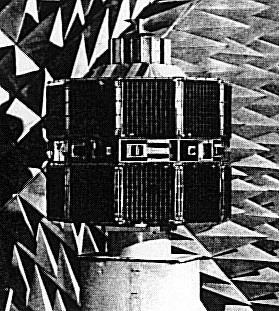
Lincoln Experimental Satellite 4, also known as LES-4, was a communications satellite, the fourth of nine in the Lincoln Experimental Satellite, and the first of the series designed for operations at geosynchronous altitudes. Launched by the United States Air Force (USAF) on 21 December 1965, it demonstrated many then-advanced technologies including active use of the military's SHF band to service hundreds of users.

While the United States Space Force gained its independence on 20 December 2019, the history of the United States Space Force can be traced back to the beginnings of the military space program following the conclusion of the Second World War in 1945. Early military space development was begun within the United States Army Air Forces by General Henry H. Arnold, who identified space as a crucial military arena decades before the first spaceflight. Gaining its independence from the Army on 18 September 1947, the United States Air Force began development of military space and ballistic missile programs, while also competing with the United States Army and United States Navy for the space mission.

Orbiting Vehicle 2-5, the third and last satellite of the second series of the United States Air Force's Orbiting Vehicle program, was an American particle science and ionosphere research satellite. Launched 26 September 1968 along with three other satellites, OV2-5 became the first scientific satellite to operate at geosynchronous altitude.

Orbiting Vehicle 1-6 was launched via Titan IIIC rocket into orbit 2 November 1966 along with two other satellites in the United States Air Force's Orbiting Vehicle series on the first and only Manned Orbiting Laboratory test flight. The eighth satellite in the OV1 series to be launched, OV1-6 was designed to release a number of inflatable spheres, which would then be used in classified tracking experiments conducted on the ground. It is uncertain whether or not the satellite successfully released any of its spheres. OV1-6 reentered the Earth's atmosphere on 31 December 1966.
























